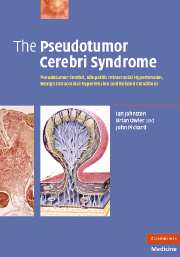 The Pseudotumor Cerebri Syndrome
The Pseudotumor Cerebri Syndrome Published online by Cambridge University Press: 21 August 2009
The condition or syndrome to be considered in this monograph has been a clearly recognized clinical entity since the descriptions given by Quincke (1893, 1897) and Nonne (1904, 1914) over 100 years ago. However, reports of cases which were almost certainly examples of the same condition undoubtedly antedated their pioneering accounts by almost four decades. The essential elements of the syndrome are the symptoms and signs of intracranial hypertension without ventricular dilatation and without an intracranial mass lesion. For reasons which will be made clear in the following chapters, we shall call it the pseudotumor cerebri syndrome (PTCS) although quite a variety of terms have been applied to it. It is a particularly intriguing condition for a number of reasons, as follows:
Clinically the condition presents an essentially pure picture of raised intracranial pressure (ICP) without focal neurological disturbance and without investigative evidence of structural disturbance, either focal or general. As such, it is a condition which manifests, in isolation, what is a critical component of many neurological and neurosurgical conditions, i.e. intracranial hypertension, thereby creating a situation in which the pathological effects of this component exist in a pure form.
Despite much speculation and numerous clinical and laboratory studies (although clinical investigations are constrained by the exigent circumstances of the condition and laboratory studies by lack of a suitable model) there is still no clear consensus on its mechanism, although the predominant view is that the intracranial hypertension is due to a disturbance of cerebrospinal fluid (CSF) dynamics.
[…]
To save this book to your Kindle, first ensure [email protected] is added to your Approved Personal Document E-mail List under your Personal Document Settings on the Manage Your Content and Devices page of your Amazon account. Then enter the ‘name’ part of your Kindle email address below. Find out more about saving to your Kindle.
Note you can select to save to either the @free.kindle.com or @kindle.com variations. ‘@free.kindle.com’ emails are free but can only be saved to your device when it is connected to wi-fi. ‘@kindle.com’ emails can be delivered even when you are not connected to wi-fi, but note that service fees apply.
Find out more about the Kindle Personal Document Service.
To save content items to your account, please confirm that you agree to abide by our usage policies. If this is the first time you use this feature, you will be asked to authorise Cambridge Core to connect with your account. Find out more about saving content to Dropbox.
To save content items to your account, please confirm that you agree to abide by our usage policies. If this is the first time you use this feature, you will be asked to authorise Cambridge Core to connect with your account. Find out more about saving content to Google Drive.